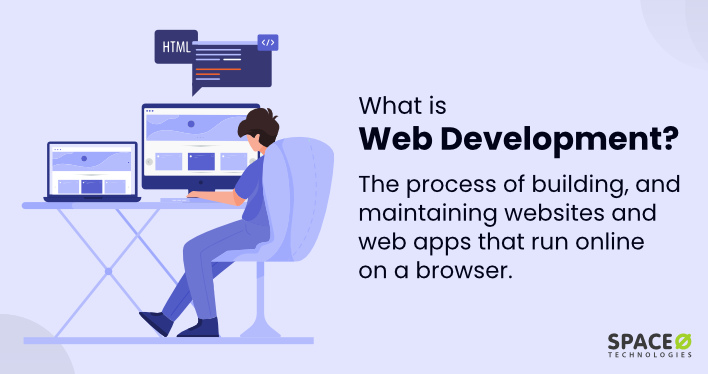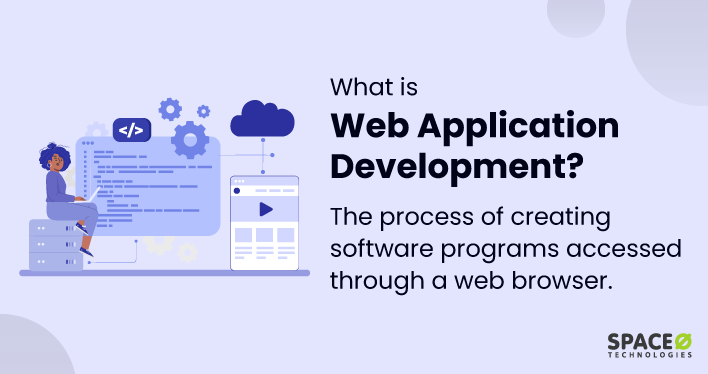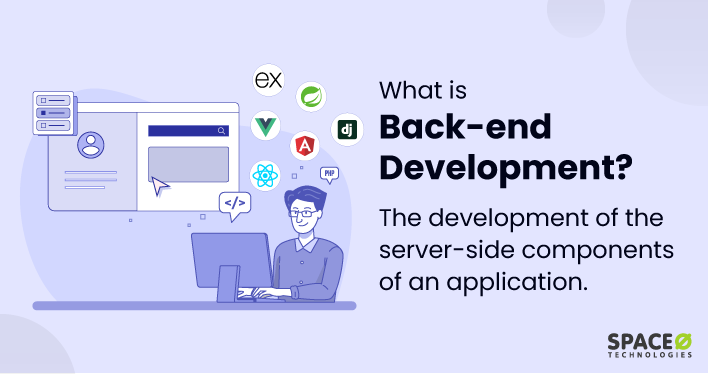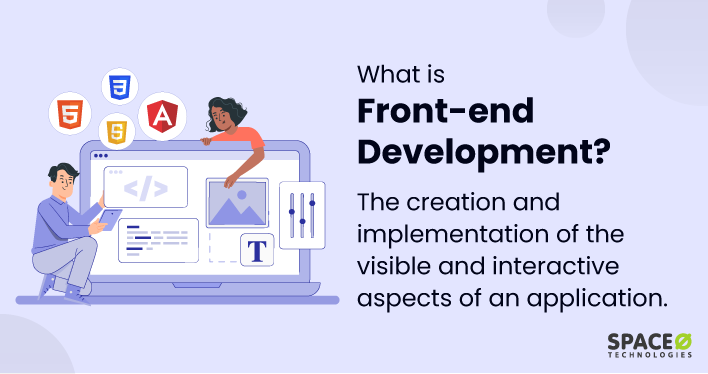Contents
What is Web Development?
Web development refers to creating, designing, building and deploying websites and web applications accessed through a web browser. It involves front-end development for user interfaces and back-end development for server-side functionality.
In web development, a full-stack developer is good at dealing with both front-end and back-end. This involves tasks such as managing web hosting, deploying applications, performing testing, implementing responsive design, ensuring security and maintaining websites.
3 Core Types of Web Development
Here are the core types of web development.
Front-end Development
Front-end web development is the process of creating and executing the user interface and the user experience (UI/UX) of a website. The technologies and tools used by front-end developers are as follows.
- HTML, CSS and JavaScript – For structure, styling, and interactivity
- React.js, Angular.js, Vue.js – Frontend frameworks
- Bootstrap, Materialize, TailwindCSS – CSS frameworks
- jQuery – JavaScript library
- AJAX, Fetch API – For asynchronous requests
- NPM, Yarn, Babel – Frontend build tools
- Git – Version control system
Back-end Development
The process of building and maintaining the server-side logic, databases, and server operations that provide functionality to a website. The technologies and tools used by back-end developers are as follows.
- Programming languages – Node.js, Python, Ruby on Rails, PHP, Java
- Frameworks – Django, Rails, Laravel, Express, Spring
- Databases – MySQL, PostgreSQL, MongoDB, SQLite
- APIs – REST, SOAP, GraphQL
- Cloud providers – AWS, Azure, GCP
- Containers and orchestration – Docker, Kubernetes
- Caching – Redis, Memcached
- Version control – Git
Full-stack Development
Full-stack development includes all of the necessary knowledge and expertise required to work on the front-end (user interface) as well as back-end (server-side) of a website or a web application. Full-stack developers are proficient in a wide range of technologies similar to those used in front-end and back-end development. Some of these technologies include.
- Text editors/IDEs – Visual Studio Code, Sublime Text
- Command -line tools
- Testing frameworks – Jest, Mocha
- CI/CD tools – Jenkins, Travis CI
- Web servers – Apache, Nginx
- Docker – for containerization
Now, you know the basic web development types. If you want to know more about front and back development as well as full-stack, you can check out our blog on 3 types of web development to know for your project. This will assist you in giving a full comparison along with the factors to consider while choosing a website development programming language.
Now, let’s talk about the complete comparison between front-end and back-end development.
Difference Between Front-end and Back-end Development
This table shows the difference between front-end development and back-end development.
| Aspect | Front-end Development | Back-end Development |
|---|---|---|
| Primary Concerns | Design, layout, and user interaction. | Data storage, server performance, and application functionality. |
| User Interaction | Handles what users see and interact with directly. | Operates behind the scenes, managing data and server operations. |
| Responsiveness | Ensures websites work seamlessly across various devices and screen sizes. | Focuses on server responsiveness and efficiency for handling requests. |
| User Interface Design | Designs the look, feel, and layout of the website or app. | Concerned with data presentation, APIs, and server responses. |
| Browser Compatibility | Ensures compatibility with different web browsers and versions. | Less focused on browser compatibility and more on server compatibility. |
| Client-Side Execution | Runs code directly on the user’s device (browser). | Executes code on the web server, away from the user’s device. |
| Performance Optimization | Focuses on client-side performance, such as rendering speed. | Concentrates on server-side performance, database queries, and response times. |
| Security | Concerned with client-side security, preventing vulnerabilities like XSS. | Emphasizes server security, data protection, and access control. |
| Testing and Debugging | Involves front-end testing tools and debugging in the browser. | Uses server-side testing tools and debugging at the server level. |
| Examples | Building interactive web pages, forms, and user interfaces. | Developing databases, APIs, server logic, and business logic. |
After covering the table. Let’s discuss the benefits of web development.
6 Major Benefits of Web Development
Here are the benefits of web development.
- Reach a global audience by having a website that can be accessed by anyone with an internet connection.
- Reduce expenses compared to traditional methods of advertising like print ads and distribution. These have big initial and ongoing costs.
- Easily fix websites by putting new stuff, features or special deals on them. This lets companies quickly change their online look.
- Helps turn more visitors into customers, and make it simple for them to find the information they need and finish what they started.
- Make it easy for people to find your website anytime, so they can get info and buy stuff whenever they like.
- You can make your website better for search engines and get more people to visit it by using techniques like SEO.
- Use detailed information and analysis to understand how visitors behave on the website. Then, change the site based on this knowledge to better attract target groups of people.
- Develop better connections with customers by including special features like personalized options and automatic processes to make custom-made experiences.
Let’s discuss the different phases of the web development process.
7 Different Phases of the Web Development Life Cycle
Here are the different phases of the web development life cycle.
- Initiate Comprehensive Project Planning: Begin by defining project goals, target audiences, and timelines, resulting in a detailed project plan.
- Craft an Exceptional User-Centric Experience: Designers create visual elements, wireframes, and mockups while selecting colors, typography, and imagery in alignment with project goals and branding.
- Execute Coding and Development: Web development teams bring the project to life by coding the user interface, and server-side logic, and integrating third-party services and APIs.
- Conduct Thorough Quality Testing: Rigorous testing, including functional, usability, and security tests, ensures the project’s proper functionality, with identified issues addressed.
- Perform Launch and Deployment: Post-testing and client approval, the project is deployed to a production environment with server, database, and hosting configurations and often includes monitoring tools setup.
- Embrace Ongoing Maintenance and Optimization: This phase involves regular updates, bug fixes, security patches, performance optimization, SEO enhancements, and feature additions to maintain project competitiveness and efficiency.
- Evaluate Post-Launch Success and Strategize: After launch, user feedback, data analysis, and metric evaluation guide further improvements and refinements for future development cycles
The above process is just an overview. If you are interested in learning the entire process of web development, you can check out our guide on the web development process to build your successful website. This will help you provide step-by-step instructions for each web development phase.
Let’s discuss the best practices for successful web development.
10 Best Practices for Successful Web Development
Here are the best practices for successful web development.
- Begin web development with a mobile-first mindset to guarantee compatibility with an array of devices and screen sizes.
- Optimize pictures, make use of browser caching, and reduce HTTP requests to optimize user experience and SEO.
- Implement encryption and safe coding standards to protect user data and avoid security breaches.
- Keep your material fresh and relevant to engage readers, promote repeat visits, and increase search engine results.
- Test sites on various browsers and devices to guarantee consistent functioning and design.
- Make your web pages easy for search engines to find by using helpful tags, clean URLs and content with important keywords.
- Stick to rules for writing code so that everyone can understand and update it easily. This helps keep things organized, easy to read, and simple to manage.
- Make sure everyone can use the website by following WCAG rules. This means putting descriptive words for pictures and using a good HTML setup.
- Save your website information often and plan for a disaster to cut down time lost if there’s an unexpected issue.
- Monitor website speed, server availability, and user activity continuously to discover and fix problems that arise.
In summary, we have covered all the aspects of web development including the types of web development and their differences, the benefits associated with web development, the entire process involved with web development and the best practices you can carry out for successfully building a website or web application.
As a leading web development services provider, we have expertise to guide you in making informed decisions about critical elements like designing visually appealing user interfaces and managing server-side operations. Our experience spans the full spectrum of web development, so we can provide strategic advice with any part of your project – whether you need assistance with planning and architecture, visual design, back-end coding, quality assurance testing, deployment, or ongoing maintenance and updates.






